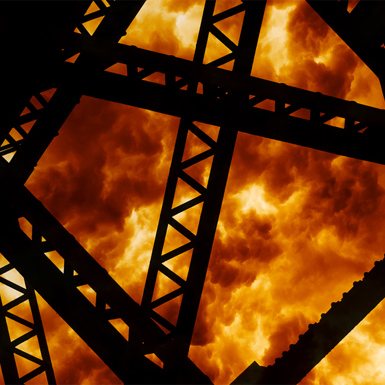Reducing the Risk of Spontaneous Combustion
This week, we welcome a guest blogger, Mark Schaaf, assistant vice president, business development liaison and risk engineering consultant with The Zurich Services Corporation as he shares suggestions for contractor clients to consider when working with oily rags.
Imagine you wake up around 2 a.m. Bewildered, with a strange feeling something is not quite right, you notice something. “Is that smoke?” you ask yourself. You decide to investigate. You look out your home’s front bedroom window and observe your neighbor’s home engulfed in smoke and flames. You call out to your sleeping partner that the neighbor’s house is on fire. Your partner responds that no one is home because they’re remodeling, then calls for the fire department.
Does this scenario sound far-fetched? Believe it or not, it’s a very real and very common occurrence. Fires caused by spontaneous combustion or chemical reaction accounted for an estimated average of 14,070 fires per year between 2005 and 2009, according to the United States Fire Administration’s National Fire Incident Reporting System (NFIRS) and the National Fire Prevention Association’s (NFPA) survey.
According to the NFIRS, fires caused by spontaneous combustion contributed to:
- 3,200 structure fires
- 1,150 vehicle fires
- 5,250 outside non-trash and unclassified fires
- 4,460 outside trash or rubbish fires
Because the fires are coded as spontaneous combustion or chemical reaction, there is no way to determine what the exact circumstances were (spontaneous combustion versus some other kind of chemical reaction). In addition, the NFIRS reports that these fires tend to occur in the afternoon or evening hours after they have had an opportunity to smolder and eventually ignite.
What causes spontaneous combustion? One of the major culprits at construction sites involves paint, stain or solvent-soaked rags improperly stored or discarded in a trash can or cardboard box in the project’s garage or structure.
Oily rags improperly stored or discarded can slowly heat to its ignition point through oxidation. If this heat has no way to escape, the temperature can elevate enough to ignite the rags. The hotter the air temperature, the faster the rags can ignite.
While fires can be a covered cause of loss under the Builders Risk Plan insured by Zurich, agents can help contractor clients reduce their risk of this hazard by sharing the following mitigation actions:
- Provide metal containers with self-closing lids and store outside of the project in an area free and clear of combustible debris, brush and organic materials
- Do not dispose of rags in cardboard boxes, trash containers or debris piles
- Consider utilizing noncombustible solvents or water-based materials whenever possible
- Store oily rags in a “listed disposal container” per NFPA 241, 5.4.3, OSHA 1926.25(c) and OSHA 1926.252.
- Dispose of and remove combustible wastes daily per NFPA 241, 5.4.1.
- Ensure fire extinguishers are available in accordance with all OSHA requirements at job sites
Share this information with clients and fellow agents. Fires due to the spontaneous combustion of oily rags can cause significant property damage and potentially the loss of life. The appropriate use, storage and disposal of rags can help reduce or eliminate the risk of spontaneous combustion fires. To learn tips to help clients reduce the risk of potentially devastating fires, download Spontaneous Combustion of Rags and Roofing Mops.
 About the Guest Blogger
About the Guest Blogger
Mark Schaaf is the assistant vice president and business development liaison who supports Zurich's Alternative Markets business by providing technical and marketing support. Developing and administering services tailored for over 30 programs throughout the North American region, Schaaf helps to achieve the desired risk selection and improvement results for property and casualty lines of coverages.
The information in this publication was compiled from sources believed to be reliable for informational purposes only. All sample policies and procedures herein should serve as a guideline, which you can use to create your own policies and procedures. We trust that you will customize these samples to reflect your own operations and believe that these samples may serve as a helpful platform for this endeavor. Any and all information contained herein is not intended to constitute advice (particularly not legal advice). Accordingly, persons requiring advice should consult independent advisors when developing programs and policies. We do not guarantee the accuracy of this information or any results and further assume no liability in connection with this publication and sample policies and procedures, including any information, methods or safety suggestions contained herein. We undertake no obligation to publicly update or revise any of this information, whether to reflect new information, future developments, events or circumstances or otherwise. Moreover, Zurich reminds you that this cannot be assumed to contain every acceptable safety and compliance procedure or that additional procedures might not be appropriate under the circumstances. The subject matter of this publication is not tied to any specific insurance product nor will adopting these policies and procedures ensure coverage under any insurance policy.
© 2017 The Zurich Services Corporation. All rights reserved.











